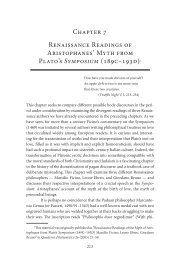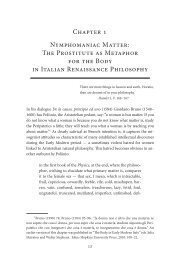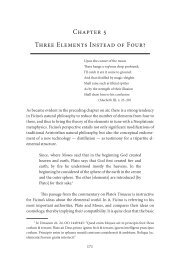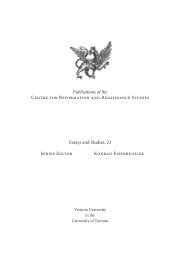Chapter 2 Matter as a Mirror: Marsilio Ficino and Renaissance ...
Chapter 2 Matter as a Mirror: Marsilio Ficino and Renaissance ...
Chapter 2 Matter as a Mirror: Marsilio Ficino and Renaissance ...
Create successful ePaper yourself
Turn your PDF publications into a flip-book with our unique Google optimized e-Paper software.
110<br />
Disreputable Bodies<br />
Even more generally speaking, all creative processes may be explained<br />
in terms of a deb<strong>as</strong>ed reflection in a mirror — for example, the way in<br />
which the form of a statue in the sculptor’s mind is subsequently impressed<br />
onto the marble. 187 The blood-stained mirror is one of the few instances<br />
where women enter <strong>Ficino</strong>’s discursive universe; significantly, the context<br />
of the female appearance is <strong>as</strong>sociated with the demonic, with action at a<br />
distance — infection through the evil eye. 188<br />
Contrary to Thom<strong>as</strong> Aquin<strong>as</strong> <strong>and</strong> other medieval authorities, <strong>Ficino</strong><br />
maintains that the material exchange in the mirror is not restricted to the<br />
terrestrial realm, that it is not limited to the specific sociological problem<br />
of potentially contagious menstruating women. According to <strong>Ficino</strong>’s metaphysics,<br />
the bloody mirror embodies one of the lowest manifestations of<br />
the sinister agency of the female <strong>as</strong>pect of Creation. The bloody mirror thus<br />
becomes a powerful metaphor that accounts for the deceptive <strong>and</strong> potentially<br />
rebellious “shadow” that is intrinsic to all created beings. Once inserted into<br />
this cosmological context, the reduction of matter to a shadow of the divine<br />
form, to a “body without a body,” 189 inherently carries with it an unwanted<br />
consequence: the corporeal, embodied world returns in the guise of the<br />
demonic, uncontrollable entities that may potentially threaten the domination<br />
of form. Because the shadow is part of, or even a creation of, the form<br />
it represents, it may, to a limited extent, retain the power of that form. We<br />
need only remember that it w<strong>as</strong> such a parthenogenetic scheme of birth that<br />
187 For a concise overview that brings mirrors, statues, echoes, <strong>and</strong> magic together see<br />
<strong>Ficino</strong>’s Epitome in Apologiam Socratis, OO 1388/384.<br />
188 Let me emph<strong>as</strong>ize that the female presence here is not a kind of allegory for positive<br />
abstract ide<strong>as</strong> such <strong>as</strong> Love, Truth, Philosophy, or divine <strong>and</strong> qu<strong>as</strong>i divine beings such<br />
<strong>as</strong> Athena, Venus, the Muses, or the Graces, but an embodied woman, a person in flesh<br />
<strong>and</strong> blood.<br />
189 See the ambiguous ontological status of images in <strong>Ficino</strong>’s Sophist commentary, ed.<br />
Allen 275 <strong>and</strong> of spiritus in De vita, III, 3: 257. Such paradoxical beings appear to fulfill a<br />
key function <strong>as</strong> mediators, tying the world together. <strong>Ficino</strong> is here influenced by Michael<br />
Psellus De daemonibus, who defines the demonic nature precisely in terms of such a paradoxical<br />
quality of disembodied embodiment: “Natura daemonum non est absque corpore,<br />
sed habet corpus, et versatur circa corpora.” (<strong>Ficino</strong>’s translation, OO 1939.) As Stephens<br />
(2002) 62, emph<strong>as</strong>izes, Aquin<strong>as</strong> (Summa theologiae I, 51, 2) <strong>as</strong>cribes the same ambiguous<br />
status to the bodies of angels <strong>and</strong> demons: “Aquin<strong>as</strong> argues that angels <strong>and</strong> devils have<br />
bodies that both are <strong>and</strong> are not real. This in-between state of reality in accompanied by<br />
the creation of a virtual body.”







